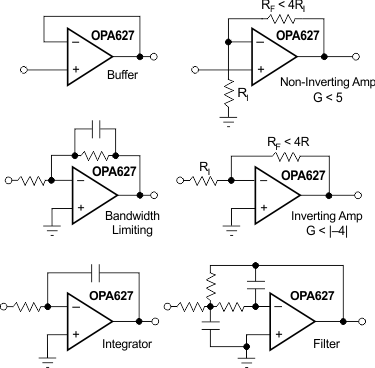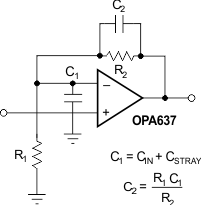JAJSS69B September 2000 – April 2024 OPA627 , OPA637
PRODMIX
- 1
- 1 特長
- 2 アプリケーション
- 3 概要
- 4 Pin Configuration and Functions
-
5 Specifications
- 5.1 Absolute Maximum Ratings
- 5.2 ESD Ratings
- 5.3 Recommended Operating Conditions
- 5.4 Thermal Information: OPA627
- 5.5 Thermal Information: OPA637
- 5.6 Electrical Characteristics: OPA627BU, OPA627AU
- 5.7 Electrical Characteristics: OPA627AM, OPA627BM, OPA627SM
- 5.8 Electrical Characteristics: OPA637
- 5.9 Typical Characteristics
- 6 Detailed Description
- 7 Application and Implementation
- 8 Device and Documentation Support
- 9 Revision History
- 10Mechanical, Packaging, and Orderable Information
パッケージ・オプション
メカニカル・データ(パッケージ|ピン)
サーマルパッド・メカニカル・データ
発注情報
6.3 Feature Description
The OPA627 is unity-gain stable. The OPA637 achieves higher speed and bandwidth in circuits with noise gain greater than 5. Noise gain refers to the closed-loop gain of a circuit, as if the noninverting operational amplifier (op amp) input were being driven. For example, the OPA637 can be used in a noninverting amplifier with gain greater than 5, or an inverting amplifier of gain greater than 4.
When choosing between the OPA627 or OPA637, consider the high frequency noise gain of the circuit configuration. Circuits with a feedback capacitor (see Figure 6-1) place the operational amplifier in unity noise-gain at high frequency. These applications must use the OPA627 for proper stability. An exception is the circuit in Figure 6-2, where a small feedback capacitance is used to compensate for the input capacitance at the inverting input of the operational amplifier. In this case, the closed-loop noise gain remains constant with frequency, so if the closed-loop gain is equal to 5 or greater, the OPA637 can be used.
 Figure 6-1 Circuits
With Noise Gain Less Than 5 Require the OPA627 for
Proper Stability
Figure 6-1 Circuits
With Noise Gain Less Than 5 Require the OPA627 for
Proper Stability Figure 6-2 Circuits
With Noise Gain Equal to or Greater Than 5 Can Use the OPA637
Figure 6-2 Circuits
With Noise Gain Equal to or Greater Than 5 Can Use the OPA637